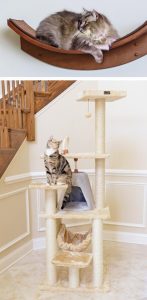
7 Steps to Creating a Cat Friendly Home

Your cat spends the majority of their time in your home so make sure it’s a kitty haven with these 7 tips for creating a cat friendly home!
1. Expand your cat’s world: create vertical space.
One of the most important aspects of creating a cat friendly home is making sure your cat has vertical space. The creation of vertical space is HUGE for cats. It opens up their space, makes it easier for cats in a multi-cat household to get along as they can “time-share” their space/assets because there are enough spots to go around, and it lets them survey their world from on high. It also encourages exercise, sorely lacking for many indoor cats, by giving them somewhere to jump to. There are many awesome (and attractive!) ways to create vertical space for your cats: amazing cat trees, cat shelves, and the connection of these vertical spaces to create “cat super highways.”
2. Provide a dining experience free of whisker stress.
Did you know the high sides of your cat’s dish bother his delicate whiskers? It’s true. Whiskers are extremely sensitive. A wide, low-sided dish suits cats best.
3. Give your cat a cocoon, not a hideaway.
Every cat friendly home needs good places for your cat to hide away and snuggle up. You should therefore provide a spot for your cat to disappear in plain sight so he can still be a part of family life but feels safe and secure. If your cat is able to “hide” by crawling into a “secret” spot off to the side of the living room.
4. Offer a room with a view. Cats love to look out windows.
Create a lookout point for your cat with a window perch or an appropriately situated shelf or bookcase. You might never know what your cat is thinking about when they spend all day staring outside, but a perch is always a kitty favourite. Though be aware that the outdoor presence of neighbourhood cats can disquiet indoor cats.
5. The multi-bathroom home.
“Cat Daddy” Jackson Galaxy recommends the “plus one” rule, meaning when determining how many litter boxes you need, count the number of cats you have and add one; if you have two cats, you’ll want three litter boxes, situated in locations with social significance to your cats. Unfortunately, your cats would like their litter boxes placed where you spend most of your time. We get that you might not want a litter box in your living room but perhaps you can compromise; if your cats spend a lot of time by certain windows or doors, place the litter boxes in these spots or in the bathroom that you use.
6. No “gas station” bathrooms please.
Cats want a clean and non-stinky place to do their business and who can blame them? Consider improving your cat’s bathroom situation by upgrading to a litter box that fights odour issues.
7. Place scratching posts where your cat wants them, rather than where you want them.
There are a number of reasons your cat is choosing the sofa and the doorjamb of your bedroom for scratching. They are important locations to your cat, marking key territory. Just reflect how much time you spend between these two locations; your cat wants to leave her mark in these key outposts to indicate her co-ownership. Instead of tucking away scratching posts where you’d like them, place them in these spots (or wherever else your cat seems to want to scratch).
Make sure the scratching posts you choose are super sturdy and provide for a variety of scratching positions—horizontal (aka what the arm of your sofa used to provide), vertical, and inclined. “Scratchability” is also important—it doesn’t help that the couch and door frames are usually made of ideal scratching material, so make sure the alternative on offer is satisfying for your cat to sink her claws into. Remember, cats aren’t just making their mark when scratching but are also stretching their back muscles and removing the outer nail sheath.
Dealing With an Aggressive Cat? 7 Reasons Why Cats Become Aggressive

No matter what the cause of the aggression, there are almost always warning signs. If you understand feline body language, you’ll be able to see that your furry friend is getting wound up before the situation escalates to a crisis point. If you have a highly reactive cat and you want to help him or her, be aware that it will take time and patience — but take it from a person who has rehabilitated traumatized cats: The reward is so worth the effort!
Is It Normal for Cats to Lose Their Teeth?
Should you worry if your cat loses a tooth? Is it normal? It depends on whether you’re talking about a kitten or an adult cat. Here’s a closer look at kitten and cat teeth so you’ll know when tooth loss is normal and when you need to visit the vet.
Do Kittens Lose Their Baby Teeth?
Like humans and all other domestic animals, cats do go through two sets of teeth throughout their lives. At only a few weeks of age, kittens will begin to get their baby teeth, which are also called “milk teeth” or deciduous teeth. The incisors—the small front teeth—are the first to erupt at 2-4 weeks of age. The premolars—larger teeth towards the back of the mouth—are the last to appear at 5-6 weeks of age, for a total of 26 baby teeth.
Adult Cat Teeth
What If Kittens Don’t Lose Their Baby Teeth?
The most commonly encountered tooth problem in kittens is the retention of baby teeth. If the baby teeth are not lost when the corresponding permanent teeth are coming in, it can result in abnormal tooth position and bite, tartar and plaque buildup, and even abscesses. But there are typically no complications if retained baby teeth are removed promptly by a veterinarian.
